Solar eclipse of March 7, 1970
| Solar eclipse of March 7, 1970 | |
|---|---|
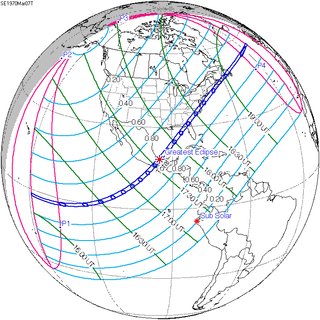 Map | |
| Type of eclipse | |
| Nature | Total |
| Gamma | 0.4473 |
| Magnitude | 1.0414 |
| Maximum eclipse | |
| Duration | 208 sec (3 m 28 s) |
| Coordinates | 18°12′N 94°42′W / 18.2°N 94.7°W |
| Max. width of band | 153 km (95 mi) |
| Times (UTC) | |
| Greatest eclipse | 17:38:30 |
| References | |
| Saros | 139 (27 of 71) |
| Catalog # (SE5000) | 9442 |
The total solar eclipse of March 7, 1970 was visible across all of North America and Central America. A solar eclipse occurs when the Moon passes between Earth and the Sun, thereby totally or partly obscuring the image of the Sun for a viewer on Earth. A total solar eclipse occurs when the Moon's apparent diameter is larger than the Sun's, blocking all direct sunlight, turning day into darkness. Totality occurs in a narrow path across Earth's surface, with the partial solar eclipse visible over a surrounding region thousands of kilometres wide. Totality was visible across southern Mexico and across the southeast coast of the United States and Canada. Greatest eclipse occurred over Mexico, with totality lasting 3 minutes and 28 seconds. Totality over the United States lasted up to 3 minutes and 10 seconds.[1] There will not be an eclipse with a greater duration of totality over the contiguous United States until the solar eclipse of April 8, 2024, a period of 54 years.
Scientific effects
The March 7 eclipse slowed a radio transmission of atomic time from North Carolina to Washington, D.C.[2]
Images

Animation of eclipse path (3 minutes per frame)
Related eclipses
Solar eclipses of 1968-1971
Each member in a semester series of solar eclipses repeats approximately every 177 days and 4 hours (a semester) at alternating nodes of the Moon's orbit.
| Ascending node | Descending node | |||||
|---|---|---|---|---|---|---|
| Saros | Map | Saros | Map | |||
| 119 |  March 28, 1968 Partial |
124 |  September 22, 1968 Total | |||
| 129 |  March 18, 1969 Annular |
134 | 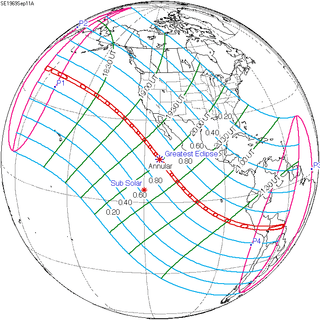 September 11, 1969 Annular | |||
| 139 |  March 7, 1970 Total |
144 |  August 31, 1970 Annular | |||
| 149 | 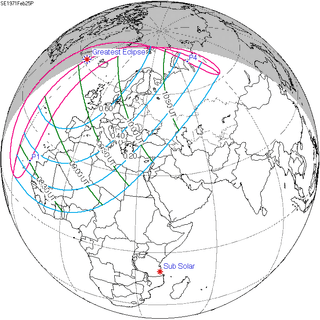 February 25, 1971 Partial |
154 |  August 20, 1971 Partial | |||
| A partial solar eclipse of July 22, 1971 occurs in the next lunar year set. | ||||||
Saros 139
It is a part of saros series 139, repeating every 18 years, 11 days, containing 71 events. The series started with partial solar eclipse on May 17, 1501. It contains hybrid eclipses on August 11, 1627 through December 9, 1825 and total eclipses from December 21, 1843 through March 26, 2601. The series ends at member 71 as a partial eclipse on July 3, 2763. Members in the same column are one exeligmos apart and thus occur in the same geographic area.
The solar eclipse of June 13, 2132 will be the longest total solar eclipse since July 11, 1991 at 6 minutes, 55 seconds.
The longest duration of totality will be produced by member 39 at 7 minutes, 29 seconds on July 16, 2186.[3] This is the longest solar eclipse computed between 4000BC and 6000AD.[4]
Series members 24-39 occur between 1901 and 2200:
| 24 | 25 | 26 |
|---|---|---|
 February 3, 1916 |
 February 14, 1934 |
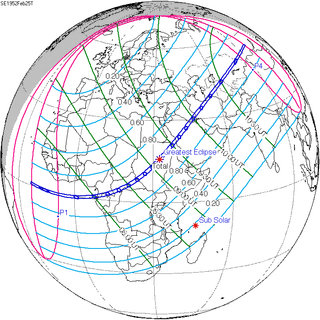 February 25, 1952 |
| 27 | 28 | 29 |
 March 7, 1970 |
 March 18, 1988 |
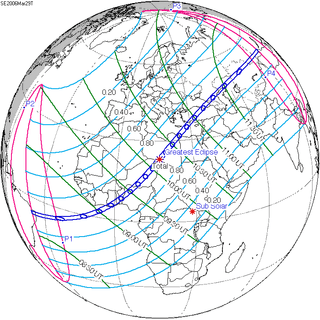 March 29, 2006 |
| 30 | 31 | 32 |
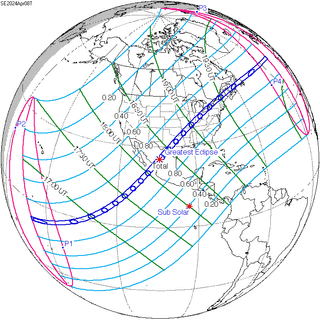 April 8, 2024 |
 April 20, 2042 |
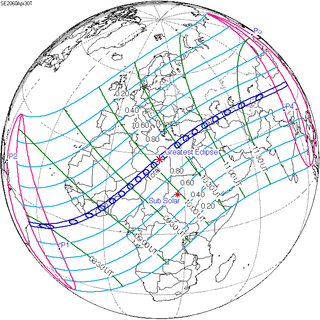 April 30, 2060 |
| 33 | 34 | 35 |
 May 11, 2078 |
 May 22, 2096 |
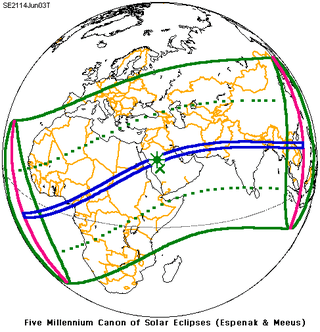 June 3, 2114 |
| 36 | 37 | 38 |
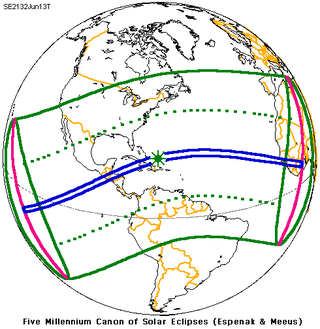 June 13, 2132 |
 June 25, 2150 |
 July 5, 2168 |
| 39 | ||
 July 16, 2186 |
Metonic series
The metonic series repeats eclipses every 19 years (6939.69 days), lasting about 5 cycles. Eclipses occur in nearly the same calendar date. In addition the octon subseries repeats 1/5 of that or every 3.8 years (1387.94 days).
This series has 21 eclipse events between July 31, 1924 and July 31, 2000.
| July 31-Aug 1 | May 19-20 | March 7 | December 24-25 | October 12 |
|---|---|---|---|---|
| 115 | 117 | 119 | 121 | 123 |
 July 31, 1924 |
 May 19, 1928 |
 March 7, 1932 |
 December 25, 1935 |
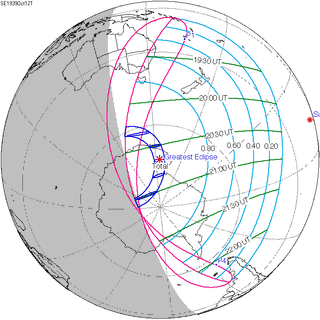 October 12, 1939 |
| 125 | 127 | 129 | 131 | 133 |
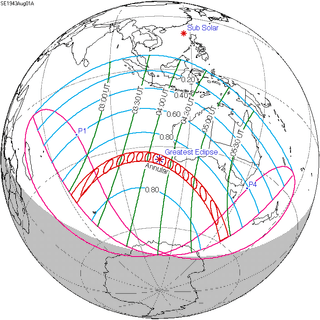 August 1, 1943 |
 May 20, 1947 |
 March 7, 1951 |
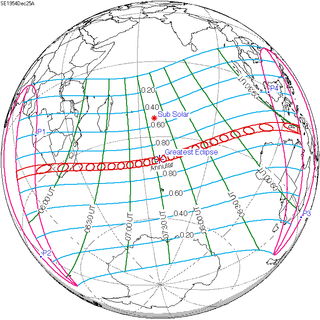 December 25, 1954 |
 October 12, 1958 |
| 135 | 137 | 139 | 141 | 143 |
 July 31, 1962 |
 May 20, 1966 |
 March 7, 1970 |
 December 24, 1973 |
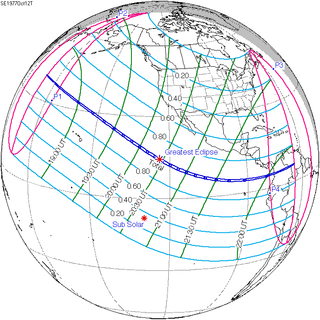 October 12, 1977 |
| 145 | 147 | 149 | 151 | 153 |
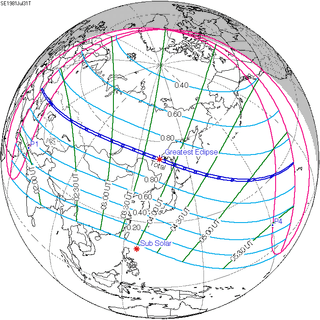 July 31, 1981 |
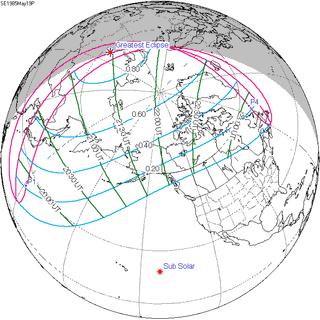 May 19, 1985 |
 March 7, 1989 |
 December 24, 1992 |
 October 12, 1996 |
| 155 | ||||
 July 31, 2000 |
In popular culture
Carly Simon's December 1972 pop hit "You're So Vain" contains the lyric "Then you flew your Learjet up to Nova Scotia to see the total eclipse of the sun," and could only have been a reference to this eclipse, not the one also over Nova Scotia on July 10, 1972, because it was actually written in 1971.
Notes
- ↑ Espenak, Fred. "TOTAL SOLAR ECLIPSE OF 1970 MAR 07". NASA Eclipse Website. Goddard Space Flight Center. Retrieved 3 June 2014.
- ↑ Sadeh, D. (1971), Phase variation of a very accurate radio frequency signal due to the solar eclipse, J. Geophys. Res., 76(34), 8427–8429, doi:10.1029/JA076i034p08427
- ↑ Saros Series Catalog of Solar Eclipses NASA Eclipse Web Site
- ↑ Ten Millennium Catalog of Long Solar Eclipses, -3999 to +6000 (4000 BCE to 6000 CE) Fred Espinak
References
- Earth visibility chart and eclipse statistics Eclipse Predictions by Fred Espenak, NASA/GSFC
Maps:
News:
Photos and observations
- Russia expedition
- Foto Solar eclipse of March 7, 1970
- Solar Eclipse Photo Gallery 1 1970-1984, Photographs by Fred Espenak, from Windsor, NC
- Observations of coronal polarization at the solar eclipse of 7 March, 1970 Polarigraphic observations of the 7 March 1970 eclipse were made at Miahuatlán (Mexico)
- Solar Eclipse of March 7, 1970 Williamston, NC by Gerard M Foley

